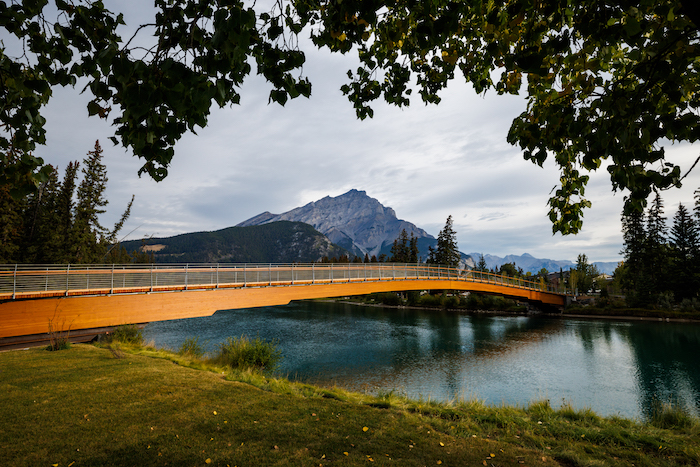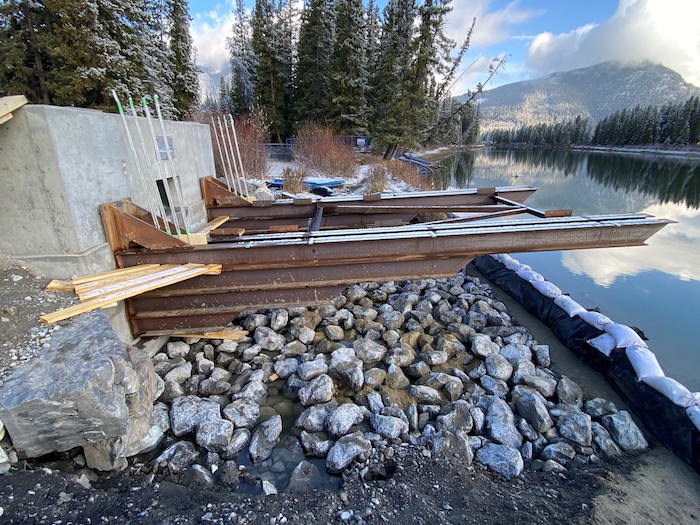
2023 #CCEAwards Showcase: Nancy Pauw Bridge
October 27, 2023
By CCE
“It’s gorgeous, with art, technique, skill and design all coming together.” – Jury
Category: Transportation
Award of Excellence Winner: StructureCraft
The aquamarine, glacier-fed Bow River traces its way through Canada’s Rocky Mountains and the town of Banff, Alta., in one of the world’s first national parks, which is visited by more than four million people annually. Today, the new Nancy Pauw Bridge spans the river right next to the town, fulfilling a 109-year dream.
Responding to demand for natural materials, StructureCraft designed and built an unusually slender 80-m clear span out of sustainable timber for this footbridge. The shallow high-thrust arch was designed to integrate well with its natural setting, without detracting from the scenery, and is expected to carry up to 10,000 pedestrians daily.
More than a century in the planning
Banff has long promoted walking and cycling. Across the river from the town centre are hot springs, natural attractions, the Banff Springs Hotel and a golf course.
As early as 1914, town planners had it in mind to locate a footbridge in Central Park, immediately adjacent to the town centre, to enable better connections. While this wish did not come true for more than 100 years, it was not for lack of trying.
In 2007, for example, an attempt was made to create a crossing, but the technical challenges were deemed too difficult and the project was abandoned.
A new opportunity recently arose, however, from a private donation offered by the Wim and Nancy Pauw Foundation. The new bridge is thus named after the late Nancy Pauw, a long-time Banff resident and hiking/cycling enthusiast.
An unprecedented design
Numerous constraints demanded a very low-profile design. StructureCraft pondered the challenge for some time before designing the slender, shallow arch.
Such a shallow arch had never been attempted before. With a 5% maximum slope at the abutments and the required clearances, it could only have a rise-to-span ratio of about 1:20. Challenges included non-linear behaviour, potential for snap-through buckling, large abutment thrusts, susceptibility to unsymmetrical loading and difficulty with vibration characteristics.
The solution was unprecedented, particularly in timber, in its high reliance on the stiffness of supports at each end, both laterally and rotationally—laterally because a shallow arch creates enormous thrusts. A small lateral deformation at the support would result in large deformations and even the collapse of the span; and rotationally because the extremely slender timber arch is very sensitive to snap-through buckling and needed stiffening at the ends.
The dense sedimentary soils would need to be able to receive the forces with very small deformation. Large-diameter piles and thick pilecaps were key components of StructureCraft’s solution. Extensive non-linear soil analysis was conducted to ensure the structure would be achievable.
Esthetics were also top-of-mind. The tapered arch design, with its slender glulam beams and weathering steel ‘haunches’ that stiffen the arch at the supports (much like the stone arches of the past), addresses the technical challenges and creates natural beauty.
Slender footbridges are very susceptible to excessive vibrations. To address both walking and jogging, StructureCraft designed a special tuned mass damper. This involved a simple carriage with weathering steel plates suspended by splayed cables from the bridge. It was fine-tuned on site and accelerometers confirmed performance, both before and after installation of the dampers.
Bridge decking consists of spaced Douglas Fir timbers. They were pre-stressed into 1-m wide removable panels using galvanized rods and rubber spacers.
The guardrail system used galvanized steel stanchions and a series of stainless steel cables, pre-stressed to special anchor stanchions at the ends. Pre-stress forces were considered to ensure performance under the expected temperature extremes.
A natural solution
The Bow River is pristine and carefully guarded by the national park and the town. Parks Canada was a necessary gatekeeper for the approvals process. Thus, the town’s brief focused on finding a low-impact, natural solution that beautified the surroundings. Environmental concerns would have to be addressed.
StructureCraft engaged both a wildlife ecologist and an environmental engineer to create a site-specific environmental protection plan. To bypass many issues with working in the river, the decision was made to not only clear-span, but also slightly over-span, to reduce the impact until negligible.
The town was also concerned about ensuring the bridge design would be in its character, which led to the selection of responsibly sourced timber for the span. The timber was also used in the most structurally efficient manner.
Further provisions were made to avoid preservative treatments; instead, low-volatile-organic compound (VOC) wood coatings were specified to help minimize maintenance. Monochromatic, dark-sky compliant, wildlife-friendly lighting was also incorporated.
Another concern was the migration of elk along the riverbanks. The landscape needed to be ‘permeable’ to their movement around the bridge. This was accomplished by minimizing the abutments and ramps, as well as by ‘berming’ up to the abutments with a maximum slope of roughly 20%, enabling the animals to pass unperturbed.
During construction, measures were taken to virtually eliminate impact on the river and surrounding environment. These included respecting nesting of migratory birds, controlling erosion and sediment, planning stream isolation, dewatering and removing cement-contaminated water during excavation and piling activities.
Indeed, environmental concerns significantly informed the footbridge’s design. It needed a clear span to minimize impact on the river and minimal slopes and ramping to mitigate impact on park lands and ensure user accessibility. It needed to provide enough clearance for flood conditions along the glacier-fed river’s low banks, while not altering the paths of the elk. Hence, an extremely low-profile bridge that appears natural and does not impose on the park and its pristine Rocky Mountains setting.
Nancy Pauw Bridge, Banff, Alta.
Award-winning firm (design-build general contractor and lead structural engineer): StructureCraft, Abbotsford, B.C. (Gerald Epp, M.Eng., P.Eng., Struct.Eng., P.E., M.IABSE, FIStructE; Leon Treder, Dipl. Ing., M.Sc.; Narong Ven, PMP, GSC).
Owner: Town of Banff, Alta.
Other key players: Thurber Engineering, Ground Cubed, Avens Consulting, Ram Consulting, Western Archrib (glulam supplier), Level Fabricators (structural steel supplier), I&J Metal Fabrications (stanchions and flashing), Bremner Engineering and Construction (civil), Bauer Foundations Canada (piling), Helms Construction (concrete and civil), Mammoet Canada Western (mobile cranes), Mike’s Electric (electrical), Paulco Landscaping, Oskar Construction (masonry).

